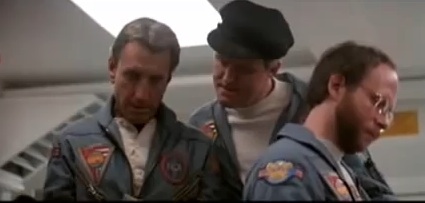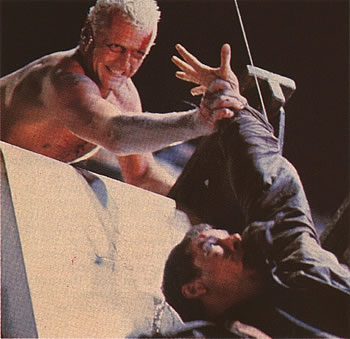Science Fiction
Dictionary
A B C D E F G H I J K L M N O P Q R S T U V W X Y Z
Do You Hold Robots Morally Accountable?

Would you hold a robot morally accountable for its behavior? The people at the Human Interaction With Nature and Technological Systems (HINTS) Lab at the University of Washington, in Seattle, wanted to know.
Autonomous robots are very close to being able to interact with human beings in a variety of ways. The folks at HINTS have published two large studies exploring whether humans view robots as moral entities.
Their intent was to study a scenario like the following:
A typical interaction is shown in the video; read the description below for an outline of the procedure.
Consider a scenario in which a domestic robot assistant accidentally breaks a treasured family heirloom; or when a semi-autonomous robotic car with a personified interface malfunctions and causes an accident; or when a robot-fighting entity mistakenly kills civilians. Such scenarios help establish the importance of the following question: Can a robot now or in the near future—say 5 or 15 years out—be morally accountable for the harm it causes?
(Moral accountability of robots study)
The first study from HINTS investigated whether humans hold a humanoid robot morally accountable for harm that it causes. The robot in question is Robovie, the little guy (little piece of equipment?) in the picture above, who was secretly being controlled by humans throughout the duration of the experiment. The experiment itself was designed to put a hapless human in a situation where they would experience Robovie making a false statement, and see how they'd react: would Robovie be responsible, or simply a malfunctioning tool?To figure this out, human subjects were introduced to Robovie, and the robot (being secretly teleoperated) made small talk with them, executing a carefully scripted set of interactions designed to establish that the robot was socially sophisticated and capable to form an increasingly social relationship between robot and human. Then, Robovie asked the subject to play a visual scavenger hunt game, with $20 at stake: the subject would attempt to find at least seven items, and if Robovie judged them to be successful (that's an important bit), within a 2-minute time limit, they'd get the money.
The game, of course, was rigged.
Overall, the study, funded by the National Science Foundation, found that:
65% of the participants attributed some level of moral accountability to Robovie for the harm that Robovie caused the participant by unfairly depriving the participant of the $20.00 prize money that the participant had won. ...We found that participants held Robovie less accountable than they would a human but more accountable than they would a machine. Thus as robots gain increasing capabilities in language comprehension and production, and engage in increasingly sophisticated social interactions with people, it is likely that many people will hold a humanoid robot as partially accountable for a harm that it causes.
Science fiction writers have spent some time exploring these topics. In the sequel to Stanley Kubrick's 2001, Dr. Chandra learns at last why the HAL-9000 computer exhibited unusual behavior in the earlier film 2001: A Space Odyssey. (SPOILER!)

(From 2010 - HAL tries to lie)
"... he was given full knowledge of the two objectives and was told not to reveal these objectives to Bowman or Poole. He was instructed to lie...The situation was in conflict with the basic purpose of HAL's design - the accurate processing of information without distortion or concealment. He became trapped... HAL was told to lie - by people who find it easy to lie.
The Bolo autonomous tanks from Keith Laumer's stories evolved to become robotic exemplars of military virtue.
In the 1982 movie Blade Runner, the replicant (non-robotic, but an artificial human) Roy Batty is given the choice to let his enemy, the human detective Rick Deckard, die, Batty instead chooses to save him.

(Roy Batty debates saving Rick Deckard in Blade Runner)
Ethical dilemmas for robots are as old as the idea of robots in fiction. Ethical behavior (in this case, self-sacrifice) is found at the end of the 1921 play Rossum's Universal Robots, by Czech playwright Karel Čapek. This play introduced the term "robot".
Update: For a hilarious counterpoint to this article, take a look at this video from the British TV series Red Dwarf in which Kryten the robot is taught to lie. You'll love Kryten's reasons for wanting to lie, and Dave's reasons for teaching him. End update.
Update: 04-Dec-2024: See the entry for Robot AI Driven Mad from Liar (1941) by Isaac Asimov. End update.
Via IEEE Spectrum
Scroll down for more stories in the same category. (Story submitted 4/27/2012)
Follow this kind of news @Technovelgy.| Email | RSS | Blog It | Stumble | del.icio.us | Digg | Reddit |
Would
you like to contribute a story tip?
It's easy:
Get the URL of the story, and the related sf author, and add
it here.
Comment/Join discussion ( 1 )
Related News Stories - (" Robotics ")
Proof Of Robothood - Not A Person
'Who are you people? - Show 'em.' - James Cameron (1984).
Dancing Robots Taught Dance Moves
'A clockwork figure would be the thing for you...' Jerome K. Jerome, 1893.
Factory Humanoid Robots Built By Humanoid Robots
'...haven't you a section of the factory where only robot labor is employed?' - Isaac Asimov (1940).
Mornine Sales Robot
'Robot-salesmen were everywhere, gesturing...' - Philip K Dick, 1954.
Technovelgy (that's tech-novel-gee!) is devoted to the creative science inventions and ideas of sf authors. Look for the Invention Category that interests you, the Glossary, the Invention Timeline, or see what's New.
Science Fiction
Timeline
1600-1899
1900-1939
1940's 1950's
1960's 1970's
1980's 1990's
2000's 2010's
Current News
Natural Gait With Prosthetic Connected To Nervous System
'The leg was to function, in a way, as a servo-mechanism operated by Larry’s brain...'
Woman Marries Computer, Vonnegut's Dream Comes True
'Men are made of protoplasm... Lasts forever.'
Spidery 'Walk Me' Toyota Autonomous Wheel Chair Like Star Wars
Walk along with the emperor.
Dancing Robots Taught Dance Moves
'A clockwork figure would be the thing for you...'
Proof Of Robothood - Not A Person
'Who are you people? - Show 'em.'
Indonesian Clans Battle
'The observation vehicle was of that peculiar variety used in conveying a large number of people across rough terrain.'
The 'Last Mile' In China Crowded With Delivery Robots
Yes, it's a delivery robot. On wheels.
Tornyol Microdrone Kills Mosquitoes
'The real border was defended by... a swarm of quasi-independent aerostats.'
PLATO Spacecraft, Hunter Of Habitable Planets, Now Ready
'I ... set my automatic astronomical instruments to searching for a habitable planet.'
Factory Humanoid Robots Built By Humanoid Robots
'...haven't you a section of the factory where only robot labor is employed?'
iPhone Air Fulfils Jobs' Promise From 2007 - A Giant Screen!
'... oblongs were all over the floor and surfaces.'
ChatGPT Now Participates in Group Chats
'...the city was their laboratory in human psychology.'
iPhone Pocket All Sold Out!
'A long, strong, slender net...'
Did The Yautja Have These First?
What a marvel of ingenuity the little device was!
Jetson ONE Air Races Begin, Can Air Polo Be Far Behind?
'If you're one of those rarities who haven't attended a rocket-polo "carnage", let me tell you it's a colorful affair.'
Will Space Stations Have Large Interior Spaces Again?
'They filed clumsily into the battleroom, like children in a swimming pool for the first time, clinging to the handholds along the side.'
